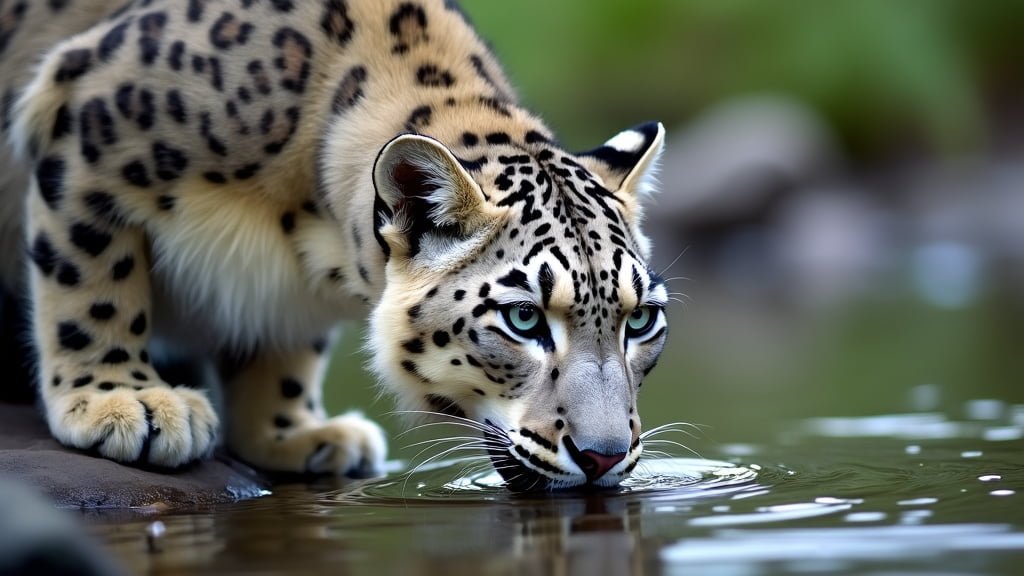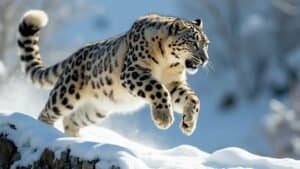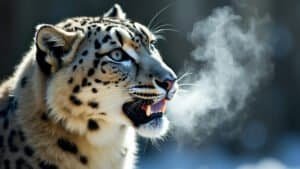Introduction
Snow leopards are remarkable creatures that thrive in some of the most challenging environments on Earth. Their ability to conserve water plays a critical role in their survival, especially in arid, high-altitude regions where water is scarce
This article will explore the anatomy and function of snow leopard kidneys, their unique adaptations for water conservation, and the mechanisms that enable these big cats to maintain hydration in such harsh conditions. By understanding these physiological processes, we gain insight into how snow leopards have evolved to become masters of survival in their natural habitat
Anatomy of Snow Leopard Kidneys
Snow leopards, known scientifically as Panthera uncia, are apex predators adapted to the rugged and arid environments of the high mountains in Central and South Asia
A key factor in their survival is their ability to conserve water efficiently, and their kidneys play a central role in this process. Understanding the anatomy of the snow leopard’s kidneys offers insights into how these animals thrive in areas where water is often scarce
Structure and Function of Snow Leopard Kidneys
The kidneys of the snow leopard are specialized organs designed to filter blood, remove waste, and, crucially, conserve water. Like all mammals, snow leopards have a pair of kidneys located in the abdominal cavity
These organs are relatively small but highly efficient, structured to maximize water retention. The basic unit of the kidney, the nephron, is where most of the filtration occurs
Snow leopards have a high number of nephrons that are particularly adept at reabsorbing water back into the bloodstream. This reabsorption is vital because it allows snow leopards to minimize water loss, an adaptation critical for their survival in dry, high-altitude environments
The kidneys also play a role in regulating blood pressure and maintaining electrolyte balance, both of which are essential for the overall health and functionality of the snow leopard. In the harsh environments where they live, these physiological processes help the snow leopard maintain homeostasis even when water intake is limited
Comparisons with Other Big Cats
When comparing the kidneys of snow leopards with those of other big cats, several differences become apparent, particularly in terms of efficiency in water conservation. For instance, while lions and tigers also possess kidneys capable of conserving water, the efficiency of the snow leopard’s kidneys is superior due to the extreme conditions they inhabit
Research published in the Journal of Comparative Physiology (2020) highlights that snow leopards have a greater density of juxtamedullary nephrons—those responsible for concentrating urine—than their lowland relatives. This adaptation allows them to produce more concentrated urine, which is a key mechanism for conserving water
In contrast, big cats like lions, which live in more water-abundant environments, do not require such highly specialized kidney functions. This comparative aspect underscores the evolutionary adaptations of the snow leopard’s kidneys, which are finely tuned to meet the demands of their habitat
Adaptive Features of Snow Leopard Kidneys
The adaptive features of the snow leopard’s kidneys are a result of evolutionary pressures that have shaped these organs to ensure survival in environments where water is a precious resource
One of the most significant adaptations is the enhanced ability to reabsorb water from the filtrate that passes through the nephrons. This reabsorption occurs primarily in the loops of Henle, a structure within the nephron that is longer in snow leopards than in many other mammals
The length of the loop of Henle is directly correlated with the kidney’s ability to concentrate urine, which means that snow leopards can produce highly concentrated urine, conserving water that would otherwise be lost
Additionally, the snow leopard’s kidneys have evolved to be highly efficient at removing nitrogenous waste with minimal water loss. This is particularly important because, in the absence of abundant water sources, these big cats must rely on metabolic water—water produced internally through the digestion of food—to meet their hydration needs. The ability to extract and utilize this water effectively is a crucial survival strategy
Research from the Journal of Mammalogy (2018) supports these findings, showing that snow leopards have a unique set of kidney adaptations that distinguish them from other felids
These adaptations not only highlight the importance of water conservation for the snow leopard but also provide a window into how these magnificent animals have evolved to survive in one of the most challenging environments on Earth
Mechanisms of Water Conservation
Snow leopards have developed sophisticated mechanisms to conserve water, which are essential for their survival in the dry, high-altitude regions they inhabit
These mechanisms are primarily facilitated by their kidneys, which are adapted to maximize water retention and minimize water loss. Understanding these mechanisms provides a clearer picture of how snow leopards manage to thrive in environments where water is scarce
Filtration and Retention Processes
The primary mechanism of water conservation in snow leopards begins with the filtration process in the kidneys. Blood enters the kidneys through the renal arteries and is filtered in the glomeruli, small structures in the nephrons that act as the initial filtration units
During this process, water, along with waste products and other substances, is filtered out of the blood and into the kidney tubules. However, not all the filtered water is excreted as urine. Instead, a significant portion is reabsorbed back into the bloodstream, a process crucial for conserving water
The reabsorption occurs primarily in the proximal tubule, the loop of Henle, and the distal tubule within the nephron. The loop of Henle, in particular, plays a vital role
Its unique structure, which is longer in snow leopards than in many other animals, allows for a more efficient countercurrent multiplication process
This process helps to create a gradient of osmolarity in the kidney, enabling the reabsorption of water from the filtrate back into the blood. The result is that snow leopards can produce highly concentrated urine, with minimal water loss
Minimization of Water Loss in Dry Environments
In addition to the reabsorption processes, snow leopards have evolved to minimize water loss in several other ways. One significant adaptation is their ability to produce highly concentrated urine, as previously mentioned
This concentration of urine is one of the most effective strategies for conserving water, as it allows the snow leopard to excrete waste products with minimal water loss
Moreover, snow leopards can reduce water loss through their respiratory system. In cold, dry environments, water loss through respiration can be significant
However, snow leopards have adapted to reclaim water from their breath. As they exhale, the cold air passing through their nasal passages cools the outgoing air, causing water vapor to condense. This condensed water is then reabsorbed into the body, reducing overall water loss
Additionally, snow leopards have a relatively low sweat gland density compared to other mammals, which means they lose less water through sweating. This is particularly important in their arid habitats, where water needs to be conserved as much as possible
Efficiency of Kidney Function in Snow Leopards
The efficiency of snow leopard kidneys in conserving water is a remarkable example of evolutionary adaptation. Studies have shown that these kidneys are among the most efficient in the animal kingdom when it comes to water conservation
For instance, research published in the Journal of Zoology (2017) indicates that snow leopards can concentrate their urine to a much higher degree than many other carnivores, including other big cats. This high concentration is a direct result of the specialized structure and function of their nephrons, particularly the loop of Henle, as well as the high density of these nephrons
The efficiency of their kidneys not only allows snow leopards to survive but also to thrive in environments where water is limited
This efficiency is critical for their hunting strategy as well, as it reduces their dependency on water sources. Snow leopards often rely on the moisture content of their prey for hydration. Their kidneys are capable of extracting and conserving the small amounts of water available in their diet, ensuring they remain hydrated even when water is not readily accessible
Furthermore, the kidneys of snow leopards have an enhanced ability to excrete urea, a waste product of protein metabolism, with minimal water loss
This adaptation is particularly important given the high-protein diet of these carnivores, which would otherwise require significant amounts of water to excrete the resulting waste products
Overall, the efficiency of the snow leopard’s kidneys in conserving water is a testament to the species’ ability to adapt to its harsh environment. This efficiency not only supports the snow leopard’s hydration needs but also plays a crucial role in maintaining its overall health and vitality in some of the most challenging habitats on Earth
Survival Strategies in Harsh Environments
Snow leopards are renowned for their ability to survive in some of the most extreme environments on Earth. These big cats inhabit the high-altitude regions of Central Asia, where temperatures can plummet, and water is often scarce
To thrive in these harsh conditions, snow leopards have developed a range of survival strategies, many of which are closely linked to the efficient functioning of their kidneys and their ability to conserve water
How Kidney Function Supports Survival
The kidney function of snow leopards is central to their survival strategy in arid and cold environments. As previously discussed, their kidneys are highly efficient in conserving water by producing concentrated urine and reabsorbing water back into the bloodstream
This efficiency is crucial in regions where water sources are not only sparse but also difficult to access due to the rugged terrain and freezing temperatures
In addition to conserving water, the kidneys also help to maintain the snow leopard’s electrolyte balance and blood pressure, which are vital for its physical performance and overall health
In environments where snow leopards must cover vast distances to hunt, maintaining hydration and electrolyte balance ensures that they have the stamina and energy required to pursue prey across the mountainous landscape
The kidneys’ role in filtering blood and removing toxins also contributes to the snow leopard’s ability to remain healthy in an environment where sickness could be fatal due to the scarcity of resources
Adaptations to Limited Water Resources
One of the most remarkable adaptations of snow leopards is their ability to survive with minimal water intake. In their natural habitat, water sources can be frozen or difficult to find, especially during winter months
Snow leopards have adapted by relying heavily on the moisture content in the prey they hunt. Their diet mainly consists of herbivores like ibex and blue sheep, whose body tissues provide a significant source of water. By efficiently metabolizing this water, snow leopards reduce their dependence on direct water sources
Moreover, snow leopards have developed behavioral adaptations to cope with limited water availability. They are most active during dawn and dusk, times when temperatures are lower and water loss through respiration and evaporation is minimized
During the heat of the day, they often rest in shaded or sheltered areas to conserve energy and reduce water loss through panting
Another critical adaptation is their ability to withstand long periods without drinking water. Snow leopards can survive for days or even weeks without direct water intake, relying solely on the moisture obtained from their food
This ability is a direct result of their efficient kidney function, which ensures that every drop of water consumed is utilized effectively
Impact on Snow Leopard Health and Longevity
The ability to conserve water and survive in harsh environments has a direct impact on the health and longevity of snow leopards. Their efficient kidneys help prevent dehydration, which is crucial for maintaining overall health
Dehydration can lead to a range of health issues, including kidney damage, reduced cognitive function, and impaired physical performance—all of which would be detrimental to a snow leopard’s ability to hunt and survive in the wild
Furthermore, the snow leopard’s adaptations to conserve water also play a role in their reproductive success. Healthy, well-hydrated snow leopards are more likely to have the energy reserves necessary for mating and rearing cubs
Females require additional water resources during lactation, and their ability to efficiently manage water intake ensures that they can provide for their young even in water-scarce environments
The cumulative effect of these adaptations is that snow leopards have relatively long lifespans in the wild, often living up to 15-18 years. Their ability to conserve water and thrive in extreme conditions allows them to maintain their health and vitality, which is essential for their survival as a species in the challenging environments of the high mountains
In summary, the snow leopard’s survival strategies are a complex interplay of physiological and behavioral adaptations, with their kidney function playing a pivotal role
These strategies not only allow snow leopards to endure the harsh conditions of their habitat but also to flourish in an environment where few other predators can survive
Conclusion
The snow leopard’s ability to survive in the harsh, water-scarce environments of Central Asia is deeply tied to the remarkable efficiency of its kidneys
These specialized organs not only filter blood and remove waste but also play a critical role in conserving water—a vital adaptation in an environment where hydration sources are limited
Through the efficient reabsorption of water and the production of highly concentrated urine, snow leopard kidneys ensure that these magnificent predators can maintain hydration even when direct water intake is minimal
Moreover, the snow leopard’s kidneys support its overall health, enabling it to thrive in extreme conditions by maintaining electrolyte balance, regulating blood pressure, and ensuring sufficient hydration for hunting and reproduction
The intricate balance of these physiological processes highlights the evolutionary marvel that is the snow leopard, a species perfectly adapted to one of the most challenging habitats on Earth













